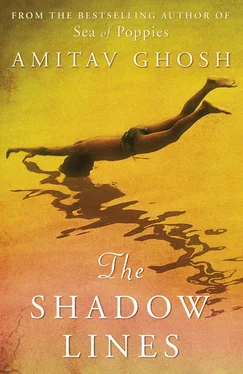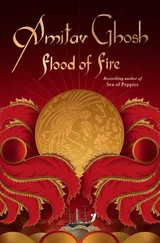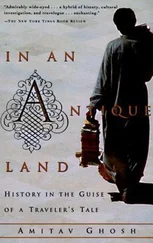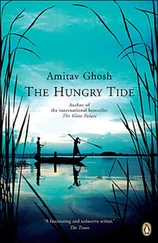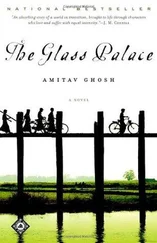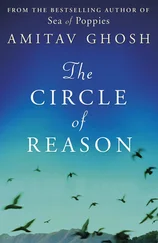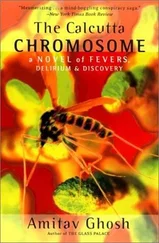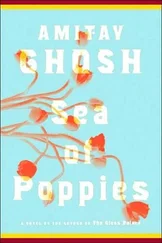Amitav Ghosh - The Shadow Lines
Здесь есть возможность читать онлайн «Amitav Ghosh - The Shadow Lines» весь текст электронной книги совершенно бесплатно (целиком полную версию без сокращений). В некоторых случаях можно слушать аудио, скачать через торрент в формате fb2 и присутствует краткое содержание. Год выпуска: 2011, Издательство: John Murray, Жанр: Современная проза, на английском языке. Описание произведения, (предисловие) а так же отзывы посетителей доступны на портале библиотеки ЛибКат.
- Название:The Shadow Lines
- Автор:
- Издательство:John Murray
- Жанр:
- Год:2011
- ISBN:нет данных
- Рейтинг книги:3 / 5. Голосов: 1
-
Избранное:Добавить в избранное
- Отзывы:
-
Ваша оценка:
- 60
- 1
- 2
- 3
- 4
- 5
The Shadow Lines: краткое содержание, описание и аннотация
Предлагаем к чтению аннотацию, описание, краткое содержание или предисловие (зависит от того, что написал сам автор книги «The Shadow Lines»). Если вы не нашли необходимую информацию о книге — напишите в комментариях, мы постараемся отыскать её.
The Shadow Lines — читать онлайн бесплатно полную книгу (весь текст) целиком
Ниже представлен текст книги, разбитый по страницам. Система сохранения места последней прочитанной страницы, позволяет с удобством читать онлайн бесплатно книгу «The Shadow Lines», без необходимости каждый раз заново искать на чём Вы остановились. Поставьте закладку, и сможете в любой момент перейти на страницу, на которой закончили чтение.
Интервал:
Закладка:
As for the two governments, they traded a series of curiously symmetrical accusations. On 7 January, a spokesman of the External Affairs Ministry in New Delhi declared that the situation of ‘lawlessness’ in East Pakistan was an ‘inevitable consequence of the incitement and provocative statements’ made by Pakistani leaders and the Pakistani press. A few days later the Indian High Commissioner in Pakistan was summoned to the External Affairs Ministry and informed of the Pakistani government’s view that the communal incidents in East Pakistan were being played up by the Indian press in order to ‘divert the people’s attention from the serious happenings in Kashmir’. But even more curiously, within a few days an almost congratulatory note entered into the exchanges between the ministries as they reviewed their respective success in ‘quelling’ the disturbances. For a while the presidents of the two countries even seriously considered issuing a joint appeal for communal harmony. But soon enough, that plan went the way of all good intentions in the subcontinent, and the memory of the riots vanished into the usual cloud of rhetorical exchanges.
In fact, from the evidence of the newspapers, it is clear that once the riots had started, both governments did everything they could to put a stop to them as quickly as possible. In this they were subject to a logic larger than themselves, for the madness of a riot is a pathological inversion, but also therefore a reminder, of that indivisible sanity that binds people to each other independently of their governments. And that prior, independent relationship is the natural enemy of government, for it is in the logic of states that to exist at all they must claim the monopoly of all relationships between peoples.
The theatre of war, where generals meet, is the stage on which states disport themselves: they have no use for memories of riots.
By the end of January 1964 the riots had faded away from the pages of the newspapers, disappeared from the collective imagination of ‘responsible opinion’, vanished without leaving a trace in the histories and bookshelves. They had dropped out of memory into the crater of a volcano of silence.
A few months after I had made my discovery in the Teen Murti Library, I found, at the bottom of my bookshelf, the tattered old Bartholomew’s Atlas in which Tridib used to point out places to me when he told me stories in his room. Mayadebi had given it to me many years before.
One day, when it was lying open on my desk in my hostel room, quite by chance I happened to find a rusty old compass at the back of my drawer. It had probably been forgotten there by the person who had lived in the room before me.
I picked it up and, toying with it, I placed its point on Khulna and the tip of the pencil on Srinagar.
Khulna is not quite one hundred miles from Calcutta as the crow flies: the two cities face each other at a watchful equidistance across the border. The distance between Khulna and Srinagar, or so I discovered when I measured the space between the points of my compass, was 1200 miles, nearly 2000 kilometres. It didn’t seem like much. But when I took my compass through the pages of that atlas, on which I could still see the smudges left by Tridib’s fingers, I discovered that Khulna is about as far from Srinagar as Tokyo is from Beijing, or Moscow from Venice, or Washington from Havana, or Cairo from Naples.
Then I tried to draw a circle with Khulna at the centre and Srinagar on the circumference. I discovered immediately that the map of South Asia would not be big enough. I had to turn back to a map of Asia before I found one large enough for my circle.
It was an amazing circle.
Beginning in Srinagar and travelling anti-clockwise, it cut through the Pakistani half of Punjab, through the tip of Rajasthan and the edge of Sind, through the Rann of Kutch, and across the Arabian Sea, through the southernmost toe of the Indian Peninsula, through Kandy, in Sri Lanka, and out into the Indian Ocean until it emerged to touch upon the northernmost finger of Sumatra, then straight through the tail of Thailand into the Gulf, to come out again in Thailand, running a little north of Phnom Penh, into the hills of Laos, past Hué in Vietnam, dipping into the Gulf of Tonking, then swinging up again through the Chinese province of Yunnan, past Chungking, across the Yangtze Kiang, passing within sight of the Great Wall of China, through Inner Mongolia and Sinkiang, until with a final leap over the Karakoram Mountains it dropped again into the valley of Kashmir.
It was a remarkable circle: more than half of mankind must have fallen within it.
And so, fifteen years after his death, Tridib watched over me as I tried to learn the meaning of distance. His atlas showed me, for example, that within the tidy ordering of Euclidean space, Chiang Mai in Thailand was much nearer Calcutta than Delhi is; that Chengdu in China is nearer than Srinagar is. Yet I had never heard of those places until I drew my circle, and I cannot remember a time when I was so young that I had not heard of Delhi or Srinagar. It showed me that Hanoi and Chungking are nearer Khulna than Srinagar, and yet did the people of Khulna care at all about the fate of the mosques in Vietnam and South China (a mere stone’s throw away)? I doubted it. But in this other direction, it took no more than a week …
In perplexity I turned back through the pages of the atlas at random, shut my eyes, and let the point of my compass fall on the page. It fell on Milan, in northern Italy. Adjusting my compass to the right scale I drew a circle which had Milan as its centre and 1200 miles as its radius.
This was another amazing circle. It passed through Helsinki in Finland, Sundsvall in Sweden, Mold in Norway, above the Shetland Islands, and then through a great empty stretch of the Atlantic Ocean until it came to Casablanca. Then it travelled into the Algerian Sahara, through Libya, into Egypt, up through the Mediterranean, where it touched on Crete and Rhodes before going into Turkey, then on through the Black Sea, into the USSR, through Crimea, the Ukraine, Byelorussia and Estonia, back to Helsinki.
Puzzling over this circle, I tried a little experiment. With my limited knowledge, I tried to imagine an event, any event, that might occur in a city near the periphery of that circle (or, indeed, much nearer) — Stockholm, Dublin, Casablanca, Alexandria, Istanbul, Kiev, any city in any direction at all — I tried to imagine an event that might happen in any of those places which would bring the people of Milan pouring out into the streets. I tried hard but I could think of none.
None, that is, other than war.
It seemed to me, then, that within this circle there were only states and citizens; there were no people at all.
When I turned back to my first circle I was struck with wonder that there had really been a time, not so long ago, when people, sensible people, of good intention, had thought that all maps were the same, that there was a special enchantment in lines; I had to remind myself that they were not to be blamed for believing that there was something admirable in moving violence to the borders and dealing with it through science and factories, for that was the pattern of the world. They had drawn their borders, believing in that pattern, in the enchantment of lines, hoping perhaps that once they had etched their borders upon the map, the two bits of land would sail away from each other like the shifting tectonic plates of the prehistoric Gondwanaland. What had they felt, I wondered, when they discovered that they had created not a separation, but a yet-undiscovered irony — the irony that killed Tridib: the simple fact that there had never been a moment in the 4000-year-old history of that map when the places we know as Dhaka and Calcutta were more closely bound to each other than after they had drawn their lines — so closely that I, in Calcutta, had only to look into the mirror to be in Dhaka; a moment when each city was the inverted image of the other, locked into an irreversible symmetry by the line that was to set us free — our looking-glass border.
Читать дальшеИнтервал:
Закладка:
Похожие книги на «The Shadow Lines»
Представляем Вашему вниманию похожие книги на «The Shadow Lines» списком для выбора. Мы отобрали схожую по названию и смыслу литературу в надежде предоставить читателям больше вариантов отыскать новые, интересные, ещё непрочитанные произведения.
Обсуждение, отзывы о книге «The Shadow Lines» и просто собственные мнения читателей. Оставьте ваши комментарии, напишите, что Вы думаете о произведении, его смысле или главных героях. Укажите что конкретно понравилось, а что нет, и почему Вы так считаете.
